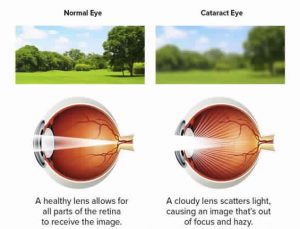 The human eye has a lens that focuses light on the retina. A cataract is the opacity of this lens. The opacity scatters the light going into the eye and blurs vision.
The human eye has a lens that focuses light on the retina. A cataract is the opacity of this lens. The opacity scatters the light going into the eye and blurs vision.
 There are different types of cataract:
There are different types of cataract:
- CORTICAL: This type of cataract causes an increasing blurring of vision. Patients generally come to us with this complaint.
- POSTERIOR SUB CPSULAR: This type of cataract causes glare from headlights and difficulty seeing in bright light.
- NUCLEAR SCLEROSIS: This type of cataract causes a decrease in the reading glasses number and patients can actually read better for some time. It causes difficulty in differentiating colors and a decrease in contrast sensitivity. Patients can still see things with high contrast like the letters on our reading charts. As the patients do not have serious visual disturbances, they tend to come to us late and cataract surgery is more traumatic for the eye. So we advise that you should get regular eye checkups, even if you do not have any complaints and make sure that you do not have this type of cataract.
Why did I get a cataract?
Age is the most common cause. Lens proteins denature and degrade over time. This process is hastened by diseases such as diabetes and hypertension. Environmental factors such as toxins, radiations, and ultraviolet light also hasten the process. Injury to the eye and steroids eye drops or systemic steroids are also known causes of cataract.
 What is the line of treatment for cataracts?
What is the line of treatment for cataracts?
Surgery is the only treatment for a cataract. There are no medicines or eye drops that can reverse the progression of cataracts. The surgery for cataract involves making a small incision in the eye, dissolving the lens opacity by an ultrasound probe, and removing it out of the eye along with fluid. A soft foldable artificial lens is then implanted to perform the function of the original lens. The new lens is implanted after measuring your eye and it can reduce the number you previously had. Various advanced lenses are now available. Those are explained in the next article.
